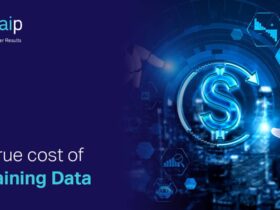A working AI model is built on solid, reliable, and dynamic datasets. Without rich and detailed AI training data at hand, it is certainly not possible to build a valuable and successful AI solution. We know that the project’s complexity dictates, and determines the required quality of data. But we are not exactly sure how much training data we need to build the custom model.
There is no straightforward answer to what the right amount of training data for machine learning is needed. Instead of working with a ballpark figure, we believe a slew of methods can give you an accurate idea of the data size you might require. But before that, let’s understand why training data is crucial for the success of your AI project.
The Significance of Training Data
Speaking at The Wall Street Journal’s Future of Everything Festival, Arvind Krishna, CEO IBM, said that nearly 80% of work in an AI Project is about collecting, cleansing, and preparing data.’ And he was also of the opinion that businesses give up their AI ventures because they cannot keep up with the cost, work, and time required to gather valuable training data.
Determining the data sample size helps in designing the solution. It also helps accurately estimate the cost, time, and skills required for the project.
If inaccurate or unreliable datasets are used to train ML models, the resultant application will not provide good predictions.
7 Factors That Determine The Volume Of Training Data Required
Though the data requirements in terms of volume to train AI models is completely subjective and should be taken on a case by case basis, there are a few universal factors that influence objectively. Let’s look at the most common ones.
Machine Learning Model
Training data volume depends on whether your model’s training runs on supervised or unsupervised learning. While the former requires more training data, the latter does not.
Supervised Learning
This involves the use of labeled data, which in turn adds complexities to the training. Tasks such as image classification or clustering require labels or attributions for machines to decipher and differentiate, leading to the demand for more data.
Unsupervised Learning
The use of labeled data is not a mandate in unsupervised learning, thus bringing down the need for humongous volumes of data comparatively. With that said, the data volume would still be high for models to detect patterns and identify innate structures and correlate them.
Variability & Diversity
For a model to be as fair and objective as possible, innate bias should be completely removed. This only translates to the fact that more volumes of diverse datasets is required. This ensures a model learns multitudes of probabilities in existence, allowing it to stay away from generating one-sided responses.
Data Augmentation And Transfer Learning
Sourcing quality data for different use cases across industries and domains is not always seamless. In sensitive sectors like healthcare or finance, quality data is scarcely available. In such cases, data augmentation involving the use of synthesized data becomes the only way forward in training models.
Experimentation And Validation
Iterative training is the balance, where the volume of training data required is calculated after consistent experimentation and validation of results. Through repeated testing and monitoring
model performance, stakeholders can gauge whether more training data is required for response optimization.
How To Reduce Training Data Volume Requirements
Regardless of whether it’s the budget constraint, go-to-market deadline, or the unavailability of diverse data, there are some options enterprises can use to reduce their dependence on huge volumes of training data.
Data Augmentation
where new data is generated or synthesized from existing datasets is ideal for use as training data. This data stems from and mimics parent data, which is 100% real data.
Transfer Learning
This involves modifying the parameters of an existing model to perform and execute a new task. For instance, if your model has learnt to identify apples, you can use the same model and modify its existing training parameters to identify oranges as well.
Pre-trained models
Where existing knowledge can be used as wisdom for your new project. This could be ResNet for tasks associated with image identification or BERT for NLP use cases.
Real-world Examples Of Machine Learning Projects With Minimal Datasets
While it may sound impossible that some ambitious machine learning projects can be executed with minimal raw materials, some cases are astoundingly true. Prepare to be amazed.
| Kaggle Report | Healthcare | Clinical Oncology |
| A Kaggle survey reveals that over 70% of the machine-learning projects were completed with less than 10,000 samples. | With only 500 images, an MIT team trained a model to detect diabetic neuropathy in medical images from eye scans. | Continuing the example with healthcare, a Stanford University team managed to develop a model to detect skin cancer with only 1000 images. |
Making Educated Guesses

There is no magic number regarding the minimum amount of data required, but there are a few rules of thumb that you can use to arrive at a rational number.
The rule of 10
As a rule of thumb, to develop an efficient AI model, the number of training datasets required should be ten times more than each model parameter, also called degrees of freedom. The ’10’ times rules aim to limit the variability and increase the diversity of data. As such, this rule of thumb can help you get your project started by giving you a basic idea about the required quantity of datasets.
Deep Learning
Deep learning methods help develop high-quality models if more data is provided to the system. It is generally accepted that having 5000 labeled images per category should be enough for creating a deep learning algorithm that can work on par with humans. To develop exceptionally complex models, at least a minimum of 10 million labeled items are required.
Computer Vision
If you are using deep learning for image classification, there is a consensus that a dataset of 1000 labeled images for each class is a fair number.
Learning Curves
Learning curves are used to demonstrate the machine learning algorithm performance against data quantity. By having the model skill on the Y-axis and the training dataset on the X-axis, it is possible to understand how the size of the data affects the outcome of the project.












